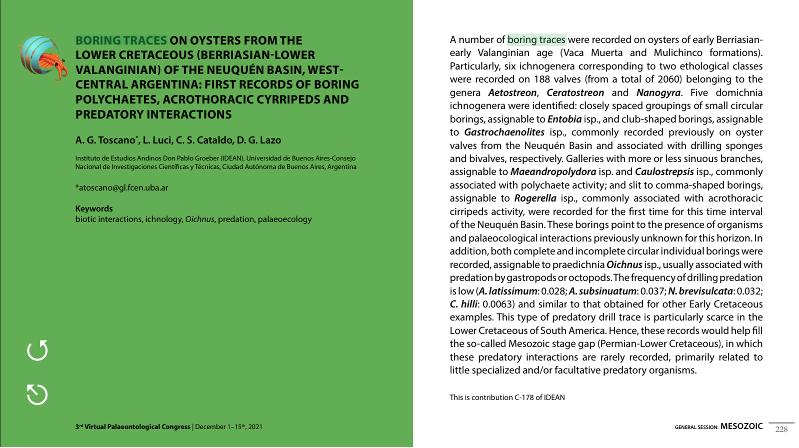Mostrar el registro sencillo del ítem
dc.contributor.author
Toscano, Agustina Gabriela

dc.contributor.author
Luci, Leticia

dc.contributor.author
Cataldo, Cecilia Soledad

dc.contributor.author
Lazo, Dario Gustavo

dc.date.available
2023-01-24T10:05:57Z
dc.date.issued
2021
dc.identifier.citation
Boring traces on oysters from the Lower Cretaceous (Berriasian-Lower Valanginian) of the Neuquén Basin, Westcentral Argentina: first records of boring polychaetes, acrothoracic cyrripeds and predatory interactions; 3rd Palaeontological Virtual Congress; Argentina; 2021; 1-1
dc.identifier.isbn
978-84-09-36657-6
dc.identifier.uri
http://hdl.handle.net/11336/185336
dc.description.abstract
A number of boring traces were recorded on oysters of early Berriasianearly Valanginian age (Vaca Muerta and Mulichinco formations). Particularly, six ichnogenera corresponding to two ethological classes were recorded on 188 valves (from a total of 2060) belonging to the genera Aetostreon, Ceratostreon and Nanogyra. Five domichnia ichnogenera were identified: closely spaced groupings of small circular borings, assignable to Entobia isp., and club-shaped borings, assignable to Gastrochaenolites isp., commonly recorded previously on oyster valves from the Neuquén Basin and associated with drilling sponges and bivalves, respectively. Galleries with more or less sinuous branches, assignable to Maeandropolydora isp. and Caulostrepsis isp., commonly associated with polychaete activity; and slit to comma-shaped borings, assignable to Rogerella isp., commonly associated with acrothoracic cirripeds activity, were recorded for the first time for this time intervalof the Neuquén Basin. These borings point to the presence of organisms and palaeocological interactions previously unknown for this horizon. In addition, both complete and incomplete circular individual borings were recorded, assignable to praedichnia Oichnus isp., usually associated withpredation by gastropods or octopods. The frequency of drilling predation is low (A. latissimum: 0.028; A. subsinuatum: 0.037; N. brevisulcata: 0.032; C. hilli: 0.0063) and similar to that obtained for other Early Cretaceous examples. This type of predatory drill trace is particularly scarce in theLower Cretaceous of South America. Hence, these records would help fill the so-called Mesozoic stage gap (Permian-Lower Cretaceous), in which these predatory interactions are rarely recorded, primarily related to little specialized and/or facultative predatory organisms.
dc.format
application/pdf
dc.language.iso
eng
dc.publisher
Palaeontological Association

dc.rights
info:eu-repo/semantics/openAccess
dc.rights.uri
https://creativecommons.org/licenses/by-nc-sa/2.5/ar/
dc.subject
Boring traces
dc.subject
Oysters
dc.subject
Cretaceous
dc.subject
Nequén Basin
dc.subject.classification
Paleontología

dc.subject.classification
Ciencias de la Tierra y relacionadas con el Medio Ambiente

dc.subject.classification
CIENCIAS NATURALES Y EXACTAS

dc.title
Boring traces on oysters from the Lower Cretaceous (Berriasian-Lower Valanginian) of the Neuquén Basin, Westcentral Argentina: first records of boring polychaetes, acrothoracic cyrripeds and predatory interactions
dc.type
info:eu-repo/semantics/publishedVersion
dc.type
info:eu-repo/semantics/conferenceObject
dc.type
info:ar-repo/semantics/documento de conferencia
dc.date.updated
2022-09-27T10:45:52Z
dc.journal.pagination
1-1
dc.journal.pais
Argentina

dc.description.fil
Fil: Toscano, Agustina Gabriela. Consejo Nacional de Investigaciones Científicas y Técnicas. Oficina de Coordinación Administrativa Ciudad Universitaria. Instituto de Estudios Andinos "Don Pablo Groeber". Universidad de Buenos Aires. Facultad de Ciencias Exactas y Naturales. Instituto de Estudios Andinos "Don Pablo Groeber"; Argentina
dc.description.fil
Fil: Luci, Leticia. Consejo Nacional de Investigaciones Científicas y Técnicas. Oficina de Coordinación Administrativa Ciudad Universitaria. Instituto de Estudios Andinos "Don Pablo Groeber". Universidad de Buenos Aires. Facultad de Ciencias Exactas y Naturales. Instituto de Estudios Andinos "Don Pablo Groeber"; Argentina
dc.description.fil
Fil: Cataldo, Cecilia Soledad. Consejo Nacional de Investigaciones Científicas y Técnicas. Oficina de Coordinación Administrativa Ciudad Universitaria. Instituto de Estudios Andinos "Don Pablo Groeber". Universidad de Buenos Aires. Facultad de Ciencias Exactas y Naturales. Instituto de Estudios Andinos "Don Pablo Groeber"; Argentina
dc.description.fil
Fil: Lazo, Dario Gustavo. Consejo Nacional de Investigaciones Científicas y Técnicas. Oficina de Coordinación Administrativa Ciudad Universitaria. Instituto de Estudios Andinos "Don Pablo Groeber". Universidad de Buenos Aires. Facultad de Ciencias Exactas y Naturales. Instituto de Estudios Andinos "Don Pablo Groeber"; Argentina
dc.relation.alternativeid
info:eu-repo/semantics/altIdentifier/url/https://drive.google.com/file/d/1XNI8UsGlEk14cR1DY0ZG6sZRBHkEkUZs/view
dc.relation.alternativeid
info:eu-repo/semantics/altIdentifier/url/https://www.prehistoire.org/offres/gestion/actus_all_515_42870-1/3rd-palaeontological-virtual-congress.html
dc.conicet.rol
Autor

dc.conicet.rol
Autor

dc.conicet.rol
Autor

dc.conicet.rol
Autor

dc.coverage
Internacional
dc.type.subtype
Congreso
dc.description.nombreEvento
3rd Palaeontological Virtual Congress
dc.date.evento
2021-12-01
dc.description.paisEvento
Argentina

dc.type.publicacion
Book
dc.description.institucionOrganizadora
Palaeontological Association
dc.source.libro
3rd Palaeontological Virtual Congress: Book of abstracts
dc.date.eventoHasta
2021-01-15
dc.type
Congreso
Archivos asociados
